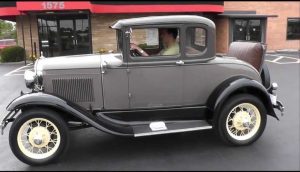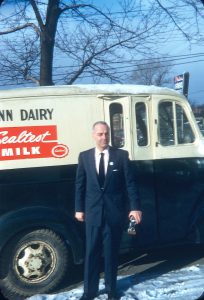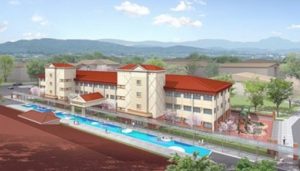Here are some events that recently came to my mind that I thought may be of interest to the reader. I present them here not in any logical order but as I thought of them.
Kenny, my friend from high school, had two brothers and a sister who were every bit as ornery as he was. At one time Kenny’s sister, Maryann, bought a table-top radio so she could listen to music on the AM band. The problem was that every time she wanted to listen to this radio one of her brothers was using it.
At that time radios used glass vacuum tubes plugged into sockets instead of the more recently invented transistors and solid-state circuits.

5 tube Table Radio
Maryann’s radio had 5 tubes that all needed to be in their sockets for the radio to function. In order to keep her brothers from using the radio without her permission Maryann removed one of the tubes and hid it, thus disabling the radio. When her brothers saw this, each one also took out a tube. Now they all had to be present in order to listen to the radio.
Its rough for a girl to be brought up in a family of boys. But who knows, since they all had to gather around the radio to listen to music, this radio may have served the same purpose as the family dinner table.
One day Kenny’s mother was grocery shopping. While checking out at the cash register she opened her purse and a large revolver fell out and rolled onto the counter. Thinking this was a robbery in progress, the checkout girl immediately went into panic mode and hit the deck. But Kenny’s mom was as surprised as the girl. Kenny and his brothers had put the revolver in their mother’s purse to embarrass her.
Good thing she was at the grocery store and not the bank!
One night about 2AM Kenny and I were sitting around wondering what we could do to pass the time. We decided to make a few phone calls and get some people out of bed. We would call a number, tell the person answering that we were from Bell Telephone Company, were testing the lines, and in order to do this he must hold the phone 3 feet away from his head and whistle. After the victim did this, we told him his phone was ok but his whistling might improve if he would eat some bird seed.
Swearing usually followed.
Bob Horning had a small dump truck and did light hauling. We called him and the conversation went something like this:
Bob (in sleepy voice): “Heelloo ” ..
Kenny: “Is this Horning Trucking?”
Bob: “Yes”.
Kenny: “Do you do light hauling?”
Bob (Thinking he was talking to a prospective customer): “Yes I do”.
Kenny: “ THEN HAUL YER ASS BACK TO BED!”
There were a few seconds of silence as we giggled in the background. After the initial shock Bob figured out what was happening and then even he couldn’t help laughing.
I guess that could be considered “light” hauling. Bob was not a very big man.
As with many of the older hard-working residents of Randolph, Bill Petty had worked all his life and had never taken a vacation. One summer he decided to take his wife on a trip out west and visit the Grand Canyon. Bill bought a new Kodak Brownie box camera in order to document this event.

Kodak Box Camera
Bill had never operated a camera before so his experience as a photographer was quite limited.
In order to aim a Brownie box camera it must be held at waist level while the operator looks down into the view finder to compose the picture.

Using a Box Camera
Bill took several rolls of film on the trip and upon returning sent them to Kodak for developing. He waited in anticipation for the photos to arrive so he could show his friends the beauty of the Canyon. When the pictures finally arrived Bill opened the package and inspected the contents. Instead of the Grand Canyon, each was a picture of Bill’s head with his mouth open looking down at the camera. He had held the camera backwards and instead of beautiful scenery each was a picture of himself!
My 1940 Ford had plastic seat covers and static electricity was a problem in cold dry weather. One cold evening while out with my girlfriend I slid across the seat to give her a kiss. A large fat spark jumped across our noses with a loud snap, and the resulting shock brought tears to our eyes.
It was a shocking experience to say the least, but it certainly enhanced my reputation as an exciting kisser!.
One cold Sunday morning when I was about 8 years old I remember my mother driving my sister and me to church in Grandpa Lang’s 1933 Cadillac. The road was slippery and Mom was quite tense – she was not comfortable driving in these conditions. We were rounding a curve when the car hit an icy patch and suddenly did a quick 180, turning completely around. The car was now pointed toward home. Mom didn’t even take her foot off the accelerator. Without hesitation or saying a word she just continued in the direction the car was now pointed.
Needless to say we did not make it to Mass. I guess Mom decided that God wanted us to stay home that day.

Lang’s 1933 Cadillac -Delores Lang standing on the fender
One evening my friends and I decided to have a beer party in the woods on top of Sand Hill. Not surprisingly, our parents didn’t approve of such things so we needed to do this on the sly. To prepare for this party Kenny and I bought a 16 gallon keg of beer at the Lakeview Cafe and put it in the trunk of Kenny’s car. The keg was too large for the trunk so the trunk lid stayed open. Kenny turned the corner too fast when crossing the square in Randolph, causing the keg to roll out of the trunk and bounce across the square. He stopped the car and we got out to retrieve our keg.
It just so happened that my dad was walking across the square at the same time. I thought, “Gene, you are now DEAD!”.
I guess Dad had his mind somewhere else. To my surprise, the event didn’t even seem to register with him. I had dodged another bullet and was able to live another day.
My mother was a mild-mannered person who hardly ever raised her voice (see previous post- Edith Lang Roliff ). She was also very religious, used proper English, and would never utter a swear word. By the time she was in her 90’s her body was racked with Parkinson’s and her voice was so weak it was hardly audible.
One evening Mom’s sisters, Alice and Irene, were at our house taking care of her and were serving dinner which included chicken and mashed potatoes. Irene put a piece of chicken on Mom’s plate and asked her where she wanted her potatoes.
“Put them on top of the chicken”, Mom said in her usual weak voice.
Irene pointed out that the potatoes should go beside the chicken, not on top. Mom again said she wanted them on top. Irene informed her that nobody puts potatoes on top of chicken. Mom again repeated that she would prefer to have the potatoes on top of the chicken. Then Alice pointed out that it is not proper etiquette to put potatoes on top of chicken and nobody does that and she had never heard of anyone ever putting potatoes on top of chicken.
“PUT THE DAMN POTATOES ON TOP OF THE GODDAM CHICKEN”, Mom exclaimed in a voice louder than anyone had heard from her in months.
So the potatoes were placed on top of the chicken.
Alice and Irene spent the remainder of the evening recovering from shock.
Brother Mark and I spent the remainder of the evening laughing.





















































































